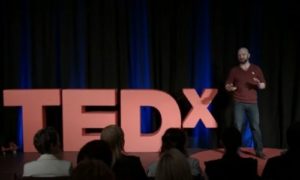Five Questions I Stole from the World’s Best Coaches, Why They Work, and How to Use Them to Start Powerful Coaching Conversations Today!
In the annals of coaching geekdom, I hope that someday there is a shrine to the total and utter dorky obsession that I have offered to the study of master coaches. I’ve spent hours watching sessions of some of the world’s best and best-known coaches, including Tony Robbins, Rich Litvin, Michael Neil, Byron Katie and plenty of others.
And while I collected a lot of questions and learned their RCFs (resting coach faces) pretty well, it wasn’t until I started putting them through the Coaching Canvas* that I started to realize this simple magic of their opening gambits.
Like a chess student finally realizing the brilliance of Bobby Fischer’s first few moves in a game, I started to discover how the world’s best coaches use simple questions to create incredible sessions and how to begin to use those same moves myself with my clients.
Over the next few days I’m going to be offering my Coaching Session Starter Mixtape, which is a compilation of four of my favorite opening questions by some of the coaches I’ve spent the most time studying. In each post I’ll explain why they work so well, what I love about them, and how you can use them with your clients starting tomorrow (or even today) to make every conversation from here on out much better than it was before.
Master Coaching Awesome OPENs Track / Question 1: What’s changed? (Tony Robbins)

To watch this question in action check out this YouTube video of Tony coaching a man at a Tony Robbins event: https://www.youtube.com/watch?v=tIg7AhfB9_A
Why it works: The client in this video is talking about how unhappy he is in his marriage and how he doesn’t want to go home and tell his wife he wants a divorce.
Tony discerns quickly from context that at some point this man loved his wife and was happy. Some coaches might be reluctant to take this leap, spending laborious minutes hearing about when he was last happy with his wife and getting tangled in a web of meaningless details.
Tony, a master at quick OPENs and DROPs at his events, instead cuts through that milieu and simply asks, “What’s changed?” In this question we can learn so much. If the man says nothing has changed we can learn that he’s unaware of the change or that he is aware something has changed. We can learn if he’s always been unhappy or if this unhappiness has a more recent cause. And most of all, Tony asks the client to tap into his own deep understanding of the situation and where Tony needs to focus the rest of the conversation.
Why I love it: This question gets so much done in the context of this conversation. This question in many ways serves both to open the context of the conversation as well as provide and entry point to the DROP Tony takes him into a few minutes later.
Perhaps the reason why I love it is the speed with which it is effective. Sometimes powerful coaching needs time and space, but often coaches use time and space because they think that’s “how it’s done,” when in reality master coaches get twice as much done in half the time by creating and using simple powerful questions that reveal lots of information at once. Also, I love that Tony is trusting his instincts here. He discerns something has changed, he guesses this guy has the answer, he directs his attention away from complaining to the situation’s larger context. All of this is possible because Tony has a hunch.
So often coaches have this idea that they shouldn’t have a hunch, but if you study the world’s best coaches, their BRILLIANCE comes from both the power of their hunch as well as their ability to offer that hunch in an unattached way. This is on display in a powerful way in this session.
How you can use it: To me this is the essence of master coaching. Whether delivered in Tony’s high-powered style or in a more gentle way, a simple question like this can reveal a lot. To use this kind of question, begin to record your hunches of what’s going on with a client as they talk and then try asking a questions that confirms or denies that hunch.
As you do this, make sure you don’t diagnose or prescribe an insight, keep your hunch a hunch, and like a scientist test your hypothesis and be ready to abandon it if the experiment yields conflicting data.
As you do remember the natural progression of hunches towards mastery:
- Clouded idea of what clients need to hear
- Realization you have no idea what clients need to hear
- Practice with not having ideas and just asking questions
- Starting to have insights about where sessions need to go
- Reluctance to go back to level 1 and trying to get clients to guess the answer you know
- Learning to offer hunches in a blurting way
- Learning to offer hunches in a gentle way
- Learning to offer hunches through skillful question experiments
- Rescue the princess from the bowser coaching castle
Okay, that’s it for today – don’t forget to tune in tomorrow where we’ll be listening to the classic and powerful “What would make this an extraordinary conversation?” used to great effect by my friend and former mentor, Rich Litvin.
* If you haven’t downloaded your own copy of the Coaching Canvas, what are you waiting for? Get yours today: https://samuraicoachingdojo.com/coaching-canvas
** Special thanks to Adam Quiney, Bay Leblanc Quiney, Christina Berkley, Kendra Cunov, Ken Blackman, David Burns, and most of all Christina Salerno (with whom I created the Coaching Canvas) for your insights and clarity that have and continue to help me improve my understanding of truly great coaching.

